Looking for detailed insights about the Los Angeles Rams players, coaches, and philosophies?
This chapter from Warren Sharp’s ‘2020 Football Preview’ book gets you prepared for the NFL season by delivering the smartest information & analysis in the fastest, most direct way possible.

It starts simple. On 1st and 10 in the first half, the 2018 Rams ran the ball on 47% of their attempts.
The 2019 Rams ran the ball on 46% of their attempts, only 1% less often than 2018.
They should have run it much less.
The 2018 Rams gained 5.9 YPC, a 62% success rate, and 0.10 EPA/carry.
The 2019 Rams gained 3.5 YPC, a 36% success rate, and -0.23 EPA/carry.
That’s a decrease of 2.4 YPC, 26% success, and 0.33 EPA.
The 2019 Rams recorded the second-worst EPA on first half 1st and 10 runs at -22.8 but the second most EPA on first half 1st and 10 passes at 29.4.
What teams do on first down directly impacts what happens on third down.
And thanks to their inefficiency on first down runs in 2019 but desire to keep their run rate (46%) close to that of 2018 (47%), the 2019 Rams faced an average of 7.2 yards to go on first half third downs. In 2018, the Rams faced an average of only 5.7 yards to go, second-best in the NFL behind only the Patriots.
I could spend the entirety of this chapter talking about the perils of overpaying a running back, of how his production is often predicated on line play, and of the domino effect from relying too much on running back production. But you’ve heard it all before. Instead, I’ll study something that hasn’t been discussed but, as it relates to the 2020 Rams, is far more important: personnel usage.
To set the tone for the 2019 Rams personnel usage, we first must look back to 2017 and 2018. In 2017, Sean McVay’s first year in LA, the Rams used 11 personnel on 81% of their offensive snaps. The NFL average was down at 59% and the prior season, the Rams were way down at 66%.
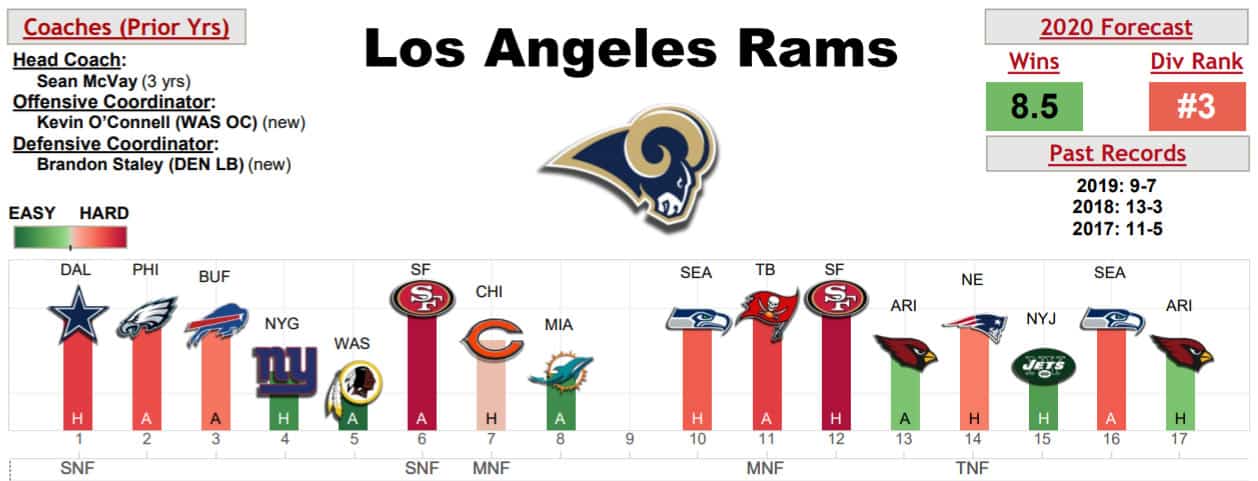
But there was something slightly peculiar about the personnel usage. When Robert Woods was healthy and the Rams had their starting 3-WR sets up (Sammy Watkins, Cooper Kupp, and Woods) the first 11 weeks of the season, they used 11 personnel on 74% of offensive plays and 85% of pass plays.
However, Woods was injured and missed entirely Week 12-14. In those three games, the Rams actually used 11 personnel on 92% of offensive plays and on 96% of pass plays. Jared Goff averaged 7.7 YPA with a 44% success rate, 0.14 EPA/att, and took seven sacks on 107 dropbacks (6.5%).
Compare that to the first 11 weeks of the season, when Goff averaged 8.2 YPA, a 46% success rate, 0.15 EPA/att, and took 15 sacks on 333 dropbacks (4.5%).
It seemed extremely odd in retrospect but wasn’t something I was aware of in-season. Woods was the Rams’ leading receiver those first 11 weeks: first in targets, receptions, yards, first downs, and touchdowns. But then he’s gone for three straight games. And instead of using less 11 personnel, McVay just upped Josh Reynolds from single-digit snaps per game to 60+. And mixed in a little more Tavon Austin. And in order to increase the usage rate of 11 personnel, Tyler Higbee’s snap rate took a dip, from 75-80% down to low 60%.
We know McVay was shocking the NFL with the 11 personnel packages, but why use even more 11 personnel when your No. 1 receiver didn’t play for three weeks?
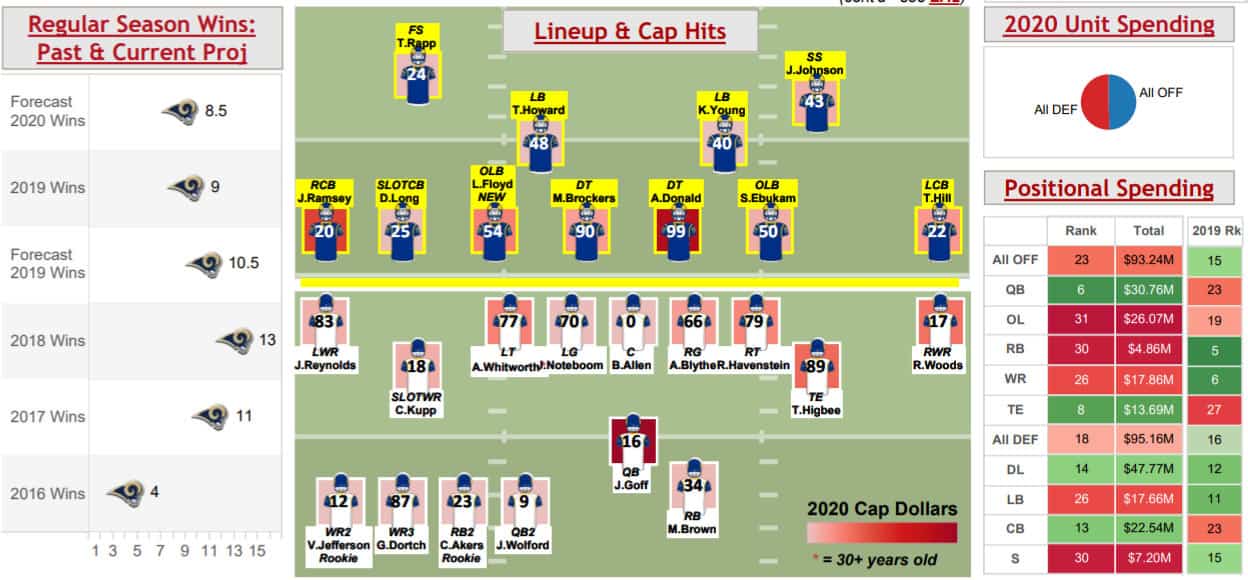
Fast forward to 2018, where the pattern continued and ultimately caught up with the Rams.
Weeks 1-4, the Rams were fully healthy and McVay ramped up the usage of 11 personnel even more. The Rams used 11 personnel on an insane 97% of their offensive plays. But then Cooper Kupp got dinged in Week 5, and for two weeks, he split reps with Josh Reynolds but played through the injury.
McVay didn’t drop the rate of 11 personnel. And apart from Week 7, when Kupp missed the first of two games and McVay used nine snaps to run the ball from 12 personnel late in a 39-10 win over the Rams, McVay didn’t lower his usage of 11. Kupp came back for Week 9 and 10, and McVay was still using 11 personnel 97% of offensive plays.
But then Kupp was lost for the season. And in the five weeks from Week 11-15, McVay didn’t change a thing with his personnel. They still used 11 on 97% of snaps and the only difference was Josh Reynolds increased from 1-2 snaps per game up to 65-75 per game.
McVay didn’t seem to let it bother him that the offense was no longer nearly as productive. Week 1-4, with a healthy offense, Goff dominated from 11, to a tune of 10.3 YPA, 59% success, 0.39 EPA/att, and five sacks (3.7% sack rate). But Weeks 11-15, even accounting for that 54-51 epic vs the Chiefs in this sample, Goff wasn’t anywhere close to as productive: 6.3 YPA, 49% success, and 11 sacks (5.9% sack rate). But the EPA difference was the most glaring.
Goff went from averaging 0.39 EPA/att down to -0.07 EPA/att. Instead of adding nearly 1 expected point every 2.6 attempts, Goff was losing expected points every attempt. On 135 attempts with Kupp in the first split, Goff totaled 52.9 EPA. He totaled -12.4 EPA in the first four games without him.
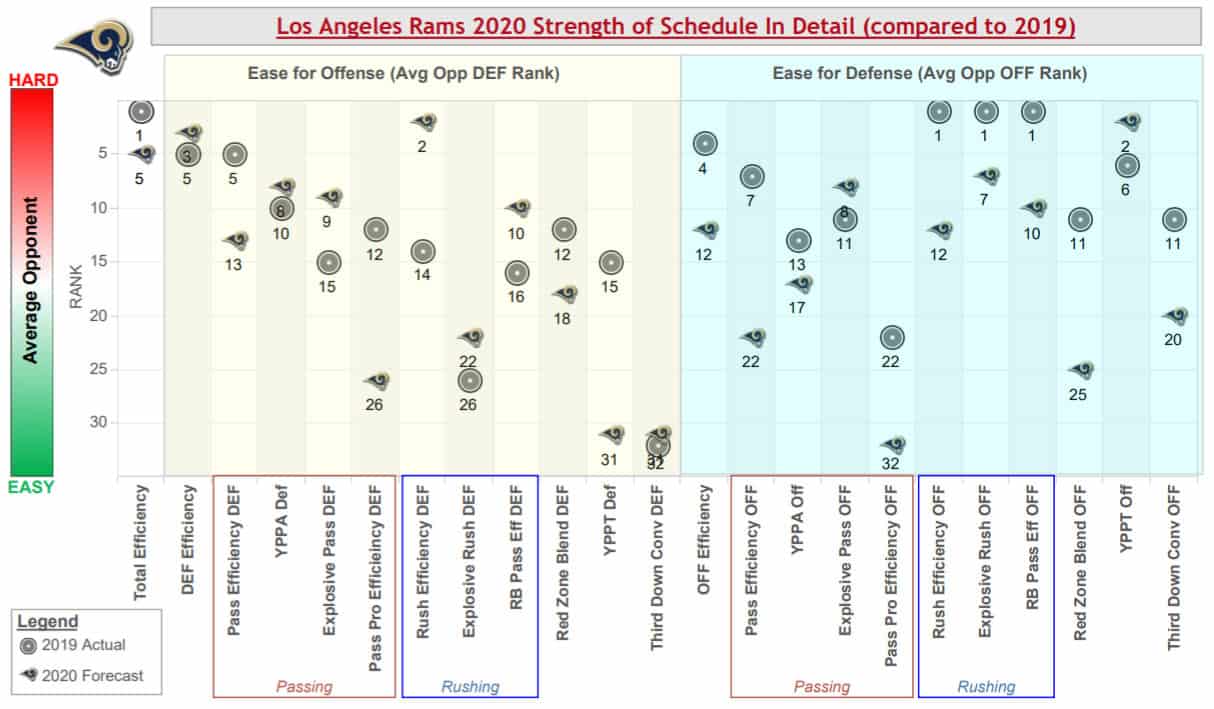
The Rams made the playoffs, made the Super Bowl, and prior to it, I implored the Rams to use more 12 personnel. The Patriots pass ranked third vs 11 personnel and 26th vs 12 personnel. So there was that. Coupled with what McVay should have known, and that was their 11 personnel wasn’t nearly as strong without Kupp, and the Rams (in limited work) had been much better passing from 12, both in efficiency and pass protection.
I hoped, for once, McVay would adjust. To his own roster’s strength and to his opponent’s weakness. But he didn’t. His first 12 personnel pass didn’t come until 3:42 left in the third quarter. For the game, 11 personnel gained 5.6 YPA with 29% success while 12 gained 8.8 YPA with 60% success, but the Rams passed 36 times from 11 personnel and only six from 12 personnel.
And now here we are, back to 2019. The tone was set by seeing the, at times, confounding way McVay used his personnel in 2017 and 2018. In 2019, McVay started out the first month using 11 personnel on 85% of snaps. Not the 97% insanity of 2018, but higher than 2017, and clearly still the highest rate in the NFL. He had all of his top receivers healthy: Robert Woods, Cooper Kupp, and Brandin Cooks, the same three starting wide receivers from 2018.
But unrelated to injury to any of them, in Weeks 5, 6, and 7 (two losses and a win), McVay started to roll out more 12 personnel. For three weeks, the Rams averaged only a 66% usage rate of 11 personnel with a 24% usage rate of 12 personnel and an 8% usage rate of 13 personnel. The heavier sets were not more efficient, they were less so:
11 personnel: 7.3 YPA, 48% success
12/13 personnel: 5.8 YPA, 33% success
They ran the ball 70% of the time from this heavier personnel, but these runs gained just 3.6 YPC with a 49% success rate. Both of which were worse than 11 personnel.
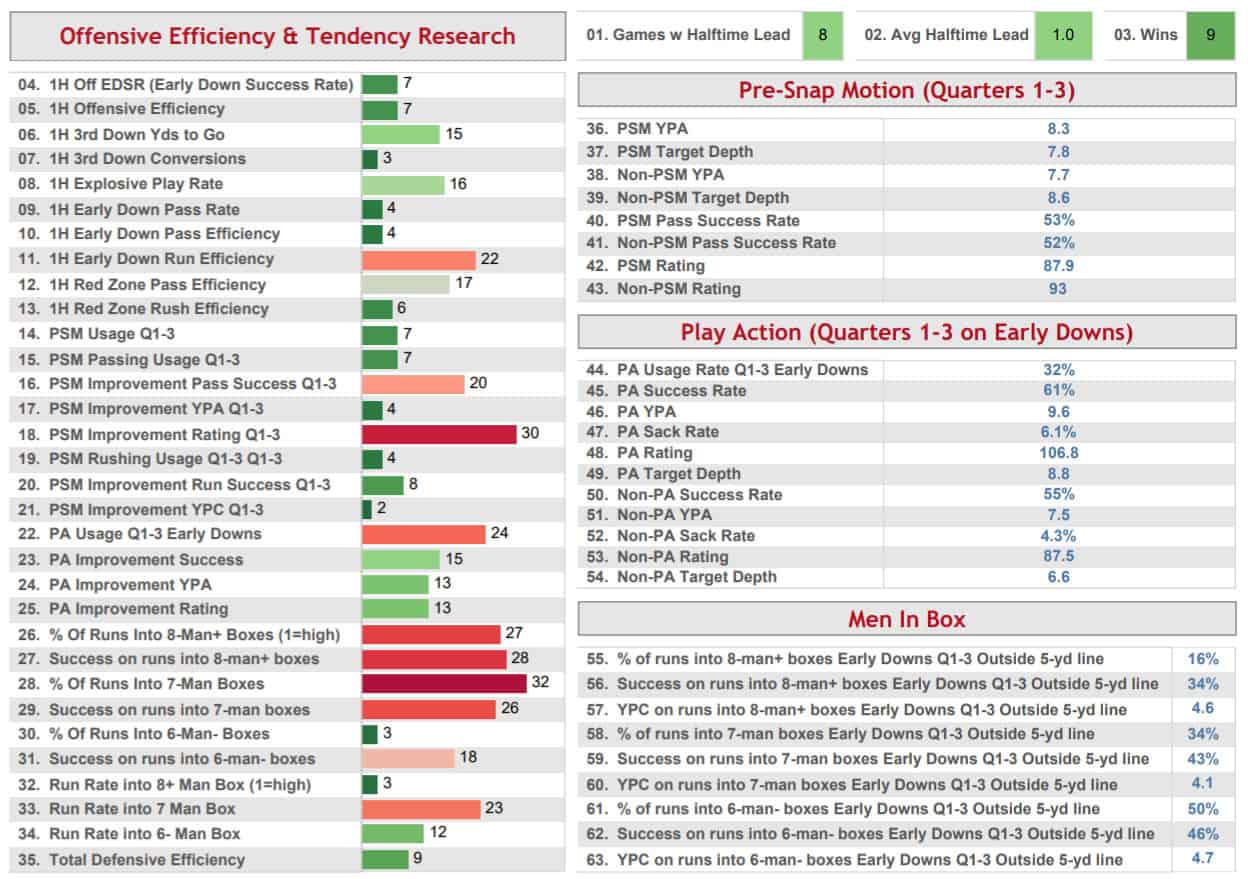
The one thing that the heavier sets did was help in pass pro: in 18 dropbacks, Goff wasn’t sacked once. But reducing those negative plays didn’t help the Rams’ chances of winning with how inefficient the groupings were otherwise.
Then Week 8 brought the Brandin Cooks injury. He played just three snaps before going down against the Bengals. Instead of upping 12 personnel, something McVay had done the prior three games, he inserted Josh Reynolds and actually upped 11, going 98% 11 personnel in Week 8. And out of a bye, with extra time to prepare and craft a game plan, McVay went 94% 11 personnel for Week 12’s game in Pittsburgh, just letting Reynolds take all the work and not increasing any 12 personnel.
How did it go? In 11 without Cooks, Goff averaged 5.1 YPA, 36% success, and a 53 rating on 47 dropbacks. He only attempted two passes from 12: 22.5 YPA, 100% success, and a 119 rating. The Rams lost.
They also lost Robert Woods, so in Week 11 against the Bears, now down Cooks and Woods, the Rams had no choice but to go heavy 12 personnel (67% 12 personnel).
But then both Woods and Cooks returned Week 12. After three weeks without a full contingent of his top three receivers, McVay had them back. And they would remain healthy and in the lineup the rest of the season. So right out of the gates, McVay went 98% 11 personnel against the Ravens and was dominated 45-6. In that game, he lost his second tight end, Gerald Everett, essentially for the rest of the season (he played four snaps the final 5 games).
One would think things would normalize. Top three wide receivers? Check. Top two tight ends? Nope. Seems like a clear recipe to go with 11. But just when you thought things couldn’t get any more strange, that was not the case.
McVay used only 64% 11 personnel the final five games of the season, and instead ramped up 12 personnel to 34% usage. But who did they get to play the second tight end if Everett was out? Enter Johnny Mundt, an undrafted free agent from Oregon who McVay drafted as part of his first class in 2017. Mundt had played on just eight dropbacks his first two years in LA. But over those final five games, Mundt totaled 213 snaps including 87 dropbacks. He was targeted just five times, caught three, and averaged 3.4 YPA.
In those final five games, passing averages:
11 personnel: 7.5 YPA, 53% success, 0.11 EPA/att
12 personnel: 7.3 YPA, 49% success, 0.27 EPA/att
Worse overall production but thanks to three touchdown passes on 45 attempts, the Rams had better EPA from 12 in those final five games.
What is the moral? After years of insisting on using 11 regardless of injuries, which cost a Super Bowl, did McVay learn:
…to use personnel based on actual personnel available? Unlikely given those final five weeks.
…to adjust personnel based on defensive weakness? Possibly.
…that constant 11 personnel wasn’t ideal and maybe more 12 could benefit Goff? Possibly.
I don’t know why McVay went to high rates of 12 personnel from Weeks 5-7 even though his receivers were healthy and it was less efficient than 11 personnel. I don’t know why, when Cooks went down in Weeks 8-10, McVay went back to high rates of 11 personnel, even though, without Cooks, 12 personnel was more efficient. And I certainly don’t know why, late in the season, with all WRs healthy, McVay went back to high rates of 12 personnel.
The best thing I can think of is the pass protection element of the heavier sets, which I suggested back before the Super Bowl. But that was primarily when the Rams didn’t have all three top wide receivers to run McVay’s scheme.
The Rams traded Cooks to the Texans and will trot out Kupp, Woods, and Reynolds as the starting three in 11 personnel. If the last three years have taught us anything about McVay’s offense, it’s that using the same amount of 11 with Reynolds starting instead of Cooks, Woods, or Kupp is no advantage. There’s a big difference over last two years in the Rams’ production out of 11 when Kupp, Woods, and Cooks were all playing compared to when one was out and Reynolds had to step in:
All 3 WRs up: 8.1 YPA, 53% success, 96.8 rating, 33:18 TD:INT, 0.13 EPA/att
Reynolds in: 7.1 YPA, 49% success, 83.1 rating, 20:13 TD:INT, 0.01 EPA/att
The Rams are returning all five offensive linemen in 2020, which is an advantage in pass pro over teams making sweeping offensive line changes in this offseason of distancing. Even so, I would advocate for more 2-TE sets in 2020. The primary reasons are simple: you no longer have ideal personnel to use 11 non-stop, you give the defense more to think about when you rotate personnel occasionally, and in 80 dropbacks with 2+ TEs last year, Jared Goff wasn’t sacked a single time. If that protection helps his performance, and all other things are somewhat equal, go with what avoids sacks and gives your quarterback more confidence in general.
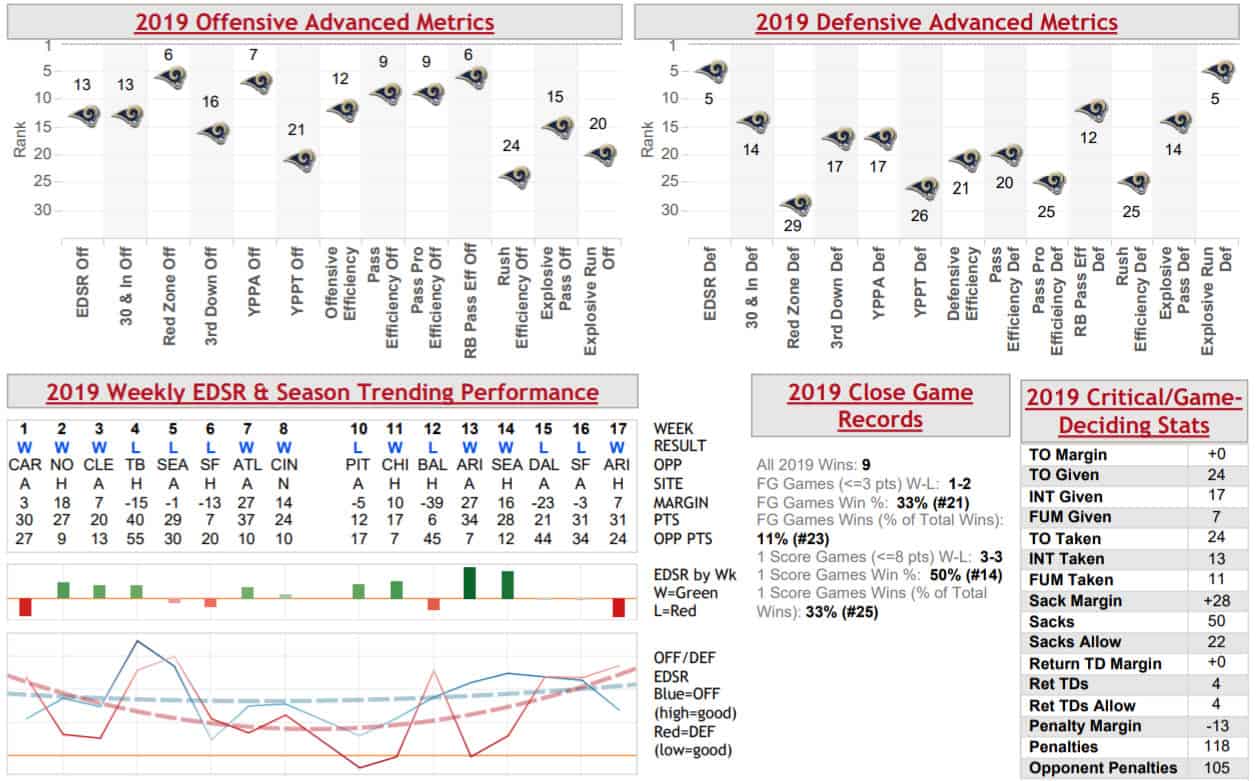
Looking at the page in this chapter on the Rams performance by personnel grouping, and comparing to the 2018 Rams, it’s clear this team was dramatically worse from all groupings as compared to 2018. Switching to more 12 is not a magic bullet. The key is, adapting your offensive strategy to your personnel on a weekly basis AND to your opponent’s weakness.
In 2019, Goff ranked 35th of 39 quarterbacks in aggressiveness and his expected completion percentage was fifth highest. Far too many easy, low risk passes. That said, Goff completed 3.6% fewer passes than expected, netting a CPOE rank of 34th of 39 quarterbacks. Another way to demonstrate how Goff became less aggressive downfield is by looking at his air yards vs YAC split. In 2019, he was 55% air yards vs 45% YAC, which ranked 16th. But he dropped to 52% air yards vs 48% YAC. And looking at his completion percentage by depth chart, it’s clear to see how much worse he was than average on anything past 15 air yards.
It was valuable to discuss the passing game and McVay’s juggling of personnel groupings, but it took away from discussing the disaster of Todd Gurley’s contract. But much like I try to do in all things I publish, I don’t want to waste too much time telling you what you already know, and would rather elaborate on areas you or other analysts might not be spending as much time studying. But as for the Rams run game, it was clearly a failure and much of that related to Gurley.
The Rams were wise to cut bait on Gurley prior to his salary cap hitting $17 million in 2020. Yes, they had to eat $20 million dead cap, but like a band-aid, it’s better to rip it right off rather than being stuck paying him $26 million in total cap (2020+2021 dead) if they cut him after this season or $35 million in total cap (2020+2021+2022 dead) if they cut him after 2021. And there was no chance he played out his contract in LA through 2023.
And what many don’t realize is the Rams don’t eat all $20 million in 2020. They have an $11.75 million dead cap hit for Gurley this year and $8.4 million in 2021. With a combined running back cap hit of $4.86 million in 2020, even factoring in dead cap the Rams are spending less on backs in 2020 than they would if they kept Gurley onboard.
The larger issue is the collective 2020 dead cap, which is a whopping $36 million, and is largely occupied by Brandin Cooks and his $21.8 million dead cap number. In total, the Rams are paying $64.8 million in 2020 — nearly a third of the cap — for Jared Goff and four players not playing for the Rams in 2020. It’s hard to build a winner with so much dead cap.
To make room for such a large cap hit, the Rams will be without Cory Littleton, one of the best coverage linebackers in the NFL with the highest tackling grade per PFF in the NFL last year, as well as Dante Fowler Jr., Eric Weddle, and Nickell Robey-Coleman. With the Cardinals improving, the 49ers still staying respectable and the Seahawks with the clear best quarterback in the division, things are going to be more difficult for the Rams in 2020 than they’ve been since Sean McVay came to town and shocked the NFL with his high usage of 11 personnel in 2017.
No team played a tougher schedule in 2019 than the Rams. It was the perfect storm for regression given the Super Bowl hangover and a brutal schedule. The bad news for the Rams? Their 2020 schedule doesn’t get much easier. They face the seventh-toughest 2020 schedule and it’s the third-toughest through three weeks and the third toughest through 12 weeks.
One of the worst elements of their schedule is that they will face the second-toughest schedule of run defenses in 2020, after facing the 14th toughest in 2019. Against top-10 run defenses in 2019, the Rams went 1-5. They went 8-2 vs non-top-10 run defenses. In 2020 they face seven run defenses that ranked in the top-10 last year.
The Rams were fortunate to get the league to put games in Philadelphia and Buffalo on back-to-back Sundays so they can stay out East. An interesting quirk to the schedule is their Week 14 meeting with the Patriots on Thursday in LA. These teams met in the Super Bowl in 2018 and Sean McVay commented that with two weeks to prepare, he spent too much time looking at old film and researching. Well, this season, he’ll have just three days to prepare.
And he must do that against Bill Belichick, a man whose teams are 13-2 on Thursdays since 2002, including 10-1 after Week 1. Since 2002, the Patriots win 75% and cover 61% of games when their opponent has fewer than a week to prepare for them and win just 67% and cover 53% when their opponent has more than a week to prepare. Of course, they’ve also had Tom Brady who won’t be available in 2020. It will make for a fascinating game.
Los Angeles Rams 2019 Passing Recap & 2020 Outlook
After two strong seasons under Sean McVay in 2017-2018, Jared Goff took a step backward a year ago. Goff posted lows in yards per pass attempt (7.4) and touchdown rate (3.5%) since his rookie season. Where Goff took an interesting turn in 2019 was in the play-action game. 32.8% of his pass attempts came via play-action, which trailed only Lamar Jackson (34.8%). But the volume was not warranted as Goff ranked 22nd in completion rate (63.1%), 13th in yards per attempt (8.4), and 26th in quarterback rating (85.9) off of the use of play-action.
He threw just four play-action touchdown passes a year ago after a league-leading 15 touchdowns in 2018. One area where Goff was still excellent was in the red zone. Goff carried a 112.0 rating in the red zone (which only trailed Jackson’s 112.7 mark among qualifying passers), and threw 18 touchdowns to zero interceptions with a 65.7% completion percentage, which ranked third in the league.
2019 Receiving Recap & 2020 Outlook
The Rams used a vastly different approach in their passing attack in 2019 versus the first two seasons under McVay. After targeting their running backs 20% and 17% of the time out of the backfield through two seasons, the Rams used their backfield a league-low 10% of the time. As a byproduct, their tight end usage rose to 26% (seventh in the league) after their tight ends received 17% and 16% target shares over the previous two seasons.
The change was successful from a rate stance, as Rams tight ends ranked eighth in the league in success rate (57%) and 12th in yards per target (7.4) while the backs ranked 30th and 32nd in the same areas.
2019 Rushing Recap & 2020 Outlook
The Rams backfield was a huge disappointment in 2019. The Rams’ backs combined for 23.2 touches (30th) for 95.5 yards from scrimmage per game (31st), averaging 4.1 yards per touch (30th). The team as a whole fared better in success rate per play on the ground (46%), but that was only good for 20th in the league while ranking 27th in yards per play (3.7 yards).
The team released Todd Gurley this offseason, leaving 2020 second-round pick Cam Akers to immediately compete with 2019 third-round pick Darrell Henderson and Malcolm Brown. Henderson managed just 43 touches for 184 yards and zero touchdowns as a rookie. Brown held an edge on Henderson for most of the season, totaling 71 touches for 271 yards.

For the complete Los Angeles Rams chapter, including a dozen more visuals & info-graphics, Defensive breakdown and detailed Fantasy football implication — plus the other 31 team chapters — pick up a copy of Warren Sharp’s new ‘2020 Football Preview’ book and use the coupon code “BOOK10” to take $10 off at purchase.















